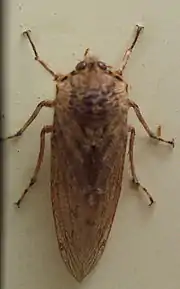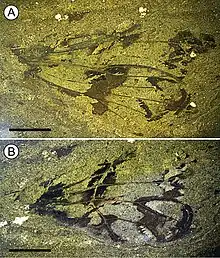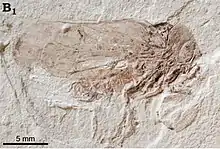Tettigarctidae
The Tettigarctidae, known as the hairy cicadas, are a small relict (mostly extinct) family of primitive cicadas. Along with more than 20 extinct genera, Tettigarctidae contains a single extant genus, Tettigarcta, with two extant species, one from southern Australia (T. crinita) and one from the island of Tasmania (T. tomentosa). Fossil taxa include Paratettigarcta from the Miocene of New Zealand,[1] Meuniera from the Paleocene of France,[2] and Sanmai from the Late Jurassic of China,[3] and Maculaferrum of early Late Cretaceous Canada.[4]Tettigarcta are the closest living relatives of the true cicadas.[5][6]
| Tettigarctidae | |
|---|---|
 | |
| Tettigarcta crinita specimen in the Australian Museum | |
| Scientific classification | |
| Kingdom: | Animalia |
| Phylum: | Arthropoda |
| Class: | Insecta |
| Order: | Hemiptera |
| Superfamily: | Cicadoidea |
| Family: | Tettigarctidae Distant, 1905 |


Genera
Only one genus in the family Tettigarctidae is not extinct, Tettigarcta.[7][8]
Family Tettigarctidae
- † Hpanraais Jiang et al. 2019 - Burmese amber, Myanmar, 99 Ma
- † Mesodiphthera Tillyard, 1919 Blackstone Formation Australia, 227–208.5 Ma
- † Tardilly Lambkin, 2019 Blackstone Formation Australia, 227–208.5 Ma
Subfamily Cicadoprosbolinae Evans, 1956
- † Maculaprosbole Zheng et al. 2016 - Daohugou Beds, China, 164.7 to 155.7 Ma
- Tribe Turutanoviini Scherbakov, 2008
- † Hirtaprosbole Liu et al. 2016 - Daohugou Beds, China, 164.7 to 155.7 Ma
- † Sanmai Chen, Zhang & Wang B 2016 - Daohugou Beds, China, 164.7 to 155.7 Ma
- † Shuraboprosbole Becker-Migdisova 1949 (syn- Paraprosbole Whalley 1985 according to Chen et al 2016) Daohugou Beds. China, Sagul Formation Kyrgyzstan, Charmouth Mudstone Formation, United Kingdom, 189.6 to 155.7 Ma
- † Tianyuprosbole Chen, Wang, Zhang & Wang, 2014 - Daohugou Beds, China, 164.7 to 155.7 Ma
- † Turutanovia Becker-Migdisova 1949 - Karabastau Formation, Kazakhstan, Mongolia, 164.7 to 112.6 Ma
- Tribe Cicadoprosbolini Evans, 1956
- † Diphtheropsis Martynov 1937 - Dzhil Formation, Sulyukta Formation Kyrgyzstan, Tajikistan, 189.6 to 183.0 Ma
- † Cicadoprosbole Becker-Migdisova 1947 - Dzhil Formation, Kyrgyzstan, 201.6 to 189.6 Ma
- † Macrotettigarcta Chen and Wang 2016 - Daohugou Beds, China, 164.7 to 155.7 Ma
- † Elkinda Shcherbakov 1988 - Turga Formation, Russia, 125.45 to 122.46 Ma
- † Shaanxiarcta Shcherbakov 2008 - Fengjiashan Formation, China, 136.4 to 125.45 Ma
- † Hylaeoneura Lameere and Severin 1897 - Sainte-Barbe Clays Formation, Belgium, 130.0 to 122.46 Ma
- † Vetuprosbole Fu, Cai and Huang, 2019 Burmese amber, Myanmar, 99 Ma
- †"Liassocicada" ignota Brodie 1845, Lilstock Formation, United Kingdom 205.6 - 201.6 Ma
- Tribe Architettigini Scherbakov, 2008
- † Architettix Hamilton 1990 - Crato Formation, Brazil, 122.46 to 112.6 Ma (million years ago)
Subfamily Tettigarctinae Distant, 1905
- †Cretotettigarcta Fu, Cai and Huang, 2019 Burmese amber, Myanmar, 99 Ma
- Tribe Protabanini Hong, 1982
- † Eotettigarcta Zeuner 1944 - Ardtun Head, Isle of Mull, United Kingdom, 58.7 to 55.8 Ma
- † Liassocicada Bode 1953 - Posidonia Shale Germany 183.0 - 182.0 Ma
- † Magrebarcta Shcherbakov 2008 - Douiret Formation, Tunisia, 125.45 to 112.6 Ma
- † Protabanus Hong 1982 - Jiulongshan Formation, China, 164.7 to 155.7 Ma
- † Sunotettigarcta Hong 1983 - Daohugou Beds, Jiulongshan Formation, China, Karabastau Formation Kazakhstan, 164.7 to 155.7 Ma
- † Tettagalma Menon 2005 - Crato Formation, Brazil, 122.46 to 112.6 Ma
- † Maculaferrum Demers-Potvin et al 2020 - Redmond Formation, Canada, 99.7 to 94.3 Ma
- Tribe Meunierini Boulard et Nel, 1990
- † Kisylia Martynov 1937 - Kyzyl-Kiya, Kyrgyzstan, 189.6 to 183.0 Ma
- † Meuniera Piton 1936 - Menat Formation, France, 58.7 to 55.8 Ma
- Tribe Tettigarctini Distant, 1905
- † Paratettigarcta Kaulfuss & Moulds 2015 - Hindon Maar, New Zealand, 23.03 to 15.97 Ma
- Tettigarcta White, 1845 - Australia, extant
See also
References
- Kaulfuss, Uwe; Moulds, Max (2015). "A new genus and species of tettigarctid cicada from the early Miocene of New Zealand: Paratettigarcta zealandica (Hemiptera, Auchenorrhyncha, Tettigarctidae)". ZooKeys (484): 83–94. doi:10.3897/zookeys.484.8883. PMC 4361785. PMID 25829843.
- Piton, L., 1936a. Les Hémiptères-Homoptères de l'Écène de Menat. (P.-de-D.). Miscellaneous Entomologica. Revue entomologique internationale. Narbonne. 37: 93-94.
- Chen, Jun; Zhang, Haichun; Wang, Bo; Zheng, Yan; Wang, Xiaoli; Zheng, Xiaoting (2016). "New Jurassic tettigarctid cicadas from China with a novel example of disruptive coloration". Acta Palaeontologica Polonica. 61 (4): 853–862. doi:10.4202/app.00238.2015.
- Demers-Potvin, Alexandre & Szwedo, Jacek & Paragnani, Cassia & Larsson, Hans. (2020). First North American occurrence of hairy cicadas discovered in a Late Cretaceous (Cenomanian) exposure from Labrador, Canada. Acta Palaeontologica Polonica. 65. 85-98. 10.4202/app.00669.2019.
- Marshall, David C.; Moulds, Max; Hill, Kathy B. R.; Price, Benjamin W.; et al. (2018). "A molecular phylogeny of the cicadas (Hemiptera: Cicadidae) with a review of tribe and subfamily classification". Zootaxa. 4424 (1): 1–64. doi:10.11646/zootaxa.4424.1.1. PMID 30313477.
- Cryan, JR; Urban, JM (2011). "Higher-level phylogeny of the insect order Hemiptera: is Auchenorrhyncha really paraphyletic?". Systematic Entomology. 37 (1): 7–21. doi:10.1111/j.1365-3113.2011.00611.x.
- Moulds, M.S. (2018). "Cicada fossils (Cicadoidea: Tettigarctidae and Cicadidae) with a review of the named fossilised Cicadidae". Zootaxa. 4438 (3): 443–470. doi:10.11646/zootaxa.4438.3.2. PMID 30313130.
- Behrensmeyer; Turner, A. "Family Tettigarctidae Distant 1905 (hairy cicada)". Fossilworks, Taxonomic occurrences of Suidae recorded in the Paleobiology Database.
External links
- CSIRO Tettigarctid page
- A photo of a Tettigarcta tomentosa
 Media related to Tettigarctidae at Wikimedia Commons
Media related to Tettigarctidae at Wikimedia Commons Data related to Tettigarctidae at Wikispecies
Data related to Tettigarctidae at Wikispecies